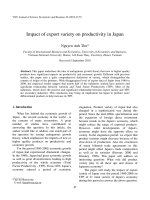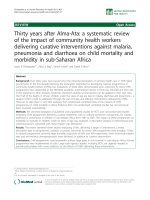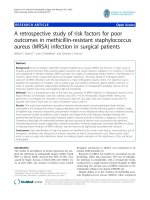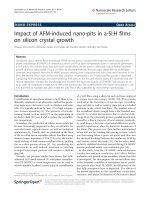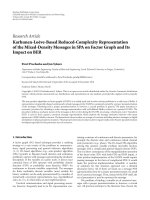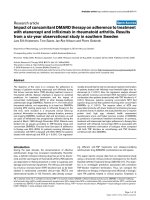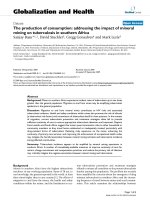Impact of perioperative hemodynamic optimization therapies in surgical patients: Economic study and meta-analysis
Bạn đang xem bản rút gọn của tài liệu. Xem và tải ngay bản đầy đủ của tài liệu tại đây (1.32 MB, 12 trang )
Silva-Jr et al. BMC Anesthesiology
(2020) 20:71
/>
RESEARCH ARTICLE
Open Access
Impact of perioperative hemodynamic
optimization therapies in surgical patients:
economic study and meta-analysis
João M. Silva-Jr1,2,3,4*, Pedro Ferro L. Menezes2,3, Suzana M. Lobo5, Flávia Helena S. de Carvalho2,
Mariana Augusta N. de Oliveira2, Francisco Nilson F. Cardoso Filho2, Bruna N. Fernando2, Maria Jose C. Carmona3,
Vanessa D. Teich4 and Luiz Marcelo S. Malbouisson3
Abstract
Background: Several studies suggest that hemodynamic optimization therapies can reduce complications, the
length of hospital stay and costs. However, Brazilian data are scarce. Therefore, the objective of this analysis was to
evaluate whether the improvement demonstrated by hemodynamic optimization therapy in surgical patients could
result in lower costs from the perspective of the Brazilian public unified health system.
Methods: A meta-analysis was performed comparing surgical patients who underwent hemodynamic optimization
therapy (intervention) with patients who underwent standard therapy (control) in terms of complications and
hospital costs. The cost-effectiveness analysis evaluated the clinical and financial benefits of hemodynamic
optimization protocols for surgical patients. The analysis considered the clinical outcomes of randomized studies
published in the last 20 years that involved surgeries and hemodynamic optimization therapy. Indirect costs
(equipment depreciation, estate and management activities) were not included in the analysis.
Results: A total of 21 clinical trials with a total of 4872 surgical patients were selected. Comparison of the
intervention and control groups showed lower rates of infectious (RR = 0.66; 95% CI = 0.58–0.74), renal (RR = 0.68;
95% CI = 0.54–0.87), and cardiovascular (RR = 0.87; 95% CI = 0.76–0.99) complications and a nonstatistically
significant lower rate of respiratory complications (RR = 0.82; 95% CI = 0.67–1.02). There was no difference in
mortality (RR = 1.02; 95% CI = 0.80–1.3) between groups. In the analysis of total costs, the intervention group
showed a cost reduction of R$396,024.83-BRL ($90,161.38-USD) for every 1000 patients treated compared to the
control group. The patients in the intervention group showed greater effectiveness, with 1.0 fewer days in the
intensive care unit and hospital. In addition, there were 333 fewer patients with complications, with a consequent
reduction of R$1,630,341.47-BRL ($371,173.27-USD) for every 1000 patients treated.
Conclusions: Hemodynamic optimization therapy is cost-effective and would increase the efficiency of and
decrease the burden of the Brazilian public health system.
Keywords: Surgery, Hemodynamic optimization, Complications, Economic, Cost-effective, Public health system
* Correspondence:
1
Anesthesiology Department, Barretos Cancer Hospital, PIOXII Foundation,
São Paulo, Brazil
2
Anesthesiology Department, Hospital do Servidor Público Estadual, IAMSPE,
São Paulo, Brazil
Full list of author information is available at the end of the article
© The Author(s). 2020 Open Access This article is licensed under a Creative Commons Attribution 4.0 International License,
which permits use, sharing, adaptation, distribution and reproduction in any medium or format, as long as you give
appropriate credit to the original author(s) and the source, provide a link to the Creative Commons licence, and indicate if
changes were made. The images or other third party material in this article are included in the article's Creative Commons
licence, unless indicated otherwise in a credit line to the material. If material is not included in the article's Creative Commons
licence and your intended use is not permitted by statutory regulation or exceeds the permitted use, you will need to obtain
permission directly from the copyright holder. To view a copy of this licence, visit />The Creative Commons Public Domain Dedication waiver ( applies to the
data made available in this article, unless otherwise stated in a credit line to the data.
Silva-Jr et al. BMC Anesthesiology
(2020) 20:71
Background
Millions of major surgeries are performed every year
worldwide [1]. The mortality and morbidity rates of highrisk surgeries vary among countries but are considered
high, making them a global problem [2–4]. In Brazil, in
2008, the mortality rate of patients admitted to intensive
care units (ICUs) after major surgeries was 15%; after 90
days, it reached 20.3%. The main postoperative complication found in Brazil was sepsis (24.7%), and the main
cause of death was multiple organ dysfunction [5].
Postoperative complications in high-risk patients undergoing major surgery are associated with low cardiorespiratory reserve and the inability to maintain adequate oxygen
delivery (O2) during surgical trauma to meet the increased
metabolic demand [6–8]. As a consequence, there is an
imbalance in the ratio of oxygen delivery to oxygen consumption, leading to hypoperfusion, multiple organ dysfunction and severe infections, which are important causes
of postoperative mortality [4]. Perioperative hemodynamic
optimization therapy aims to adjust cardiac function to
meet the increased demand during the perioperative period,
thus avoiding hypovolemia or hypervolemia and, ultimately,
tissue hypoperfusion and postoperative complications. This
requires adequate hemodynamic monitoring to guide the
early treatment of each patient, allowing earlier identification of the need for fluid optimization, blood transfusion,
and vasoactive drugs.
Studies and meta-analyses have shown that perioperative hemodynamic optimization therapy has a significant
impact on the outcomes of high-risk patients undergoing
major surgery, potentially decreasing morbidity and
mortality, the length of ICU stay, and the length of hospital stay [9–11]. However, the risk-benefit ratio of this
type of monitoring has been questioned because it is invasive and carries risks [12]. Monitoring techniques include pulmonary artery catheterization, transpulmonary
thermodilution, echocardiography, transesophageal Doppler echocardiography, pulse contour analysis, partial
carbon dioxide rebreathing and bioimpedance.
Cost-effectiveness is represented by a ratio between monetary cost, usually expressed in a national currency, in the
numerator and a measure of health gain in the denominator. The poor adherence to perioperative hemodynamic
optimization therapy in clinical practice combined with the
need to improve the effectiveness of care for surgical patients in the face of increasing demand points to the urgent
need for cost-effectiveness assessments that encourage the
use of perioperative hemodynamic optimization therapy in
this area, particularly in resource-limited settings.
Health resources are increasingly limited, and a lack of
knowledge on a method is a barrier to the implementation of new therapies with proven effectiveness that
could not only save lives but also lead to a reduction in
resource use. Our hypothesis is that these interventions,
Page 2 of 12
due to their significant impact on the length of hospital
stay and complications, would be cost-effective for the
public health system.
This study aimed to evaluate whether the use of perioperative hemodynamic optimization therapy is costeffective for patients undergoing major surgery from the
perspective of the Brazilian unified health system by
evaluating the impact of a reduction in the length of
hospital stay, complication rates and mortality on hospital costs.
Methods
A systematic review of the clinical trials indexed in CENTRAL (PubMed), MEDLINE (OvidSP) and EMBASE
(OvidSP) between 2001 and 2018 was performed. The
search used the following keywords, which were expected
to be present in the title and/or abstract: “randomized
studies” and “surgeries”, and/or “perioperative”, and/or
“high-risk”, and/or “complications”, and/or “intraoperative” and/or “postoperative”, and/or “cardiac output”, and/
or “cardiac index”, and/or “hemodynamic monitoring”,
and/or “hemodynamic optimization therapy”, and/or
“hemodynamic intervention”, and/or “cost-effectiveness”,
and/or “mortality”. Methods identical to those recommended by the Cochrane systematic review of randomized
controlled trials on increased blood flow to the organs,
with explicitly defined goals and results after surgery, were
used.
Only studies published in the English language were included. Two independent researchers identified the titles
and abstracts of the potentially eligible studies. Disagreements between the investigators were resolved by a consensus. Two other researchers extracted the following
data from the full texts of potentially eligible studies: study
design, patient population, interventions and outcomes.
Similar to the approach used for the selection of texts, any
disagreements between researchers regarding the data extraction were resolved by a consensus. Each included
study was assessed independently by the first and second
reviewers for risk of bias in random sequencing generation, allocation concealment, blinding of participants and
personnel, blinding of outcomes assessment, incomplete
outcome data, selective reporting, and other sources of
bias using the Cochrane Risk of Bias Tool [13]. In the absence of appropriate published data, at least one attempt
was made to contact the authors of eligible studies to obtain necessary data. The analysis was performed with the
best available information when there was no response.
The following information and outcomes were recorded: number of patients with respiratory complications (i.e., the need for respiratory support for more
than 24 h after surgery, hypoxemia, and acute changes in
lung mechanics), cardiovascular complications (need for
hemodynamic support, such as the use of inotropes and
Silva-Jr et al. BMC Anesthesiology
(2020) 20:71
vasopressors during the postoperative period), renal
complications (oliguria, unexpected increase in creatinine
and need for dialysis) and infectious complications (infections that occurred during the postoperative period) based
on the records of each study. Mortality was assessed
throughout the longer follow-up period (primary outcome) or was examined as in-hospital mortality. Many
studies reported complications as the number of complications rather than the number of patients with complications, but we examined only the last unit in the analysis,
which was the number of complications per patient.
To calculate the costs of these complications, only the
length of ICU stay was considered.
The inclusion criteria of the selected studies were as
follows:
1) studies in adult patients (18 years or older);
2) studies with patients undergoing hemodynamic
optimization therapy with some type of cardiac
output monitor;
3) studies that related the costs of hemodynamic
optimization therapy and its outcomes, such as the
reduction in mortality or morbidity rates or the
reduction in the length of hospital or ICU stay; and
4) interventional studies comparing the use of invasive
or minimally invasive monitoring with the standard
strategy for hemodynamic optimization to alter
clinical outcomes. The intervention should meet
the following criteria:
Perioperative period: The administration of fluids with
or without inotropes/vasoactive drugs to increase blood
flow (standard therapy group) was compared with goals
measured explicitly with invasive or minimally invasive
hemodynamic monitoring (intervention group). The perioperative period started at the beginning of surgery and
lasted up to 24 h after surgery. Explicit goals were defined
for the cardiac index, oxygen delivery (DO2), oxygen consumption, systolic volume, mixed or central venous oxygen saturation, oxygen extraction, or serum lactate.
The exclusion criteria were as follows:
1) animal studies;
2) studies published prior to 2001;
3) observational studies that did not use clinical
intervention to change outcomes or case reports; and
4) studies involving critically ill patients prior to
intervention or with established sepsis who
therefore had a high probability of unfavorable
outcomes and death regardless of the intervention.
Cost assessment
For the cost-effectiveness analysis, the costs were separated
into 10 categories and two periods: the intraoperative
Page 3 of 12
period (monitoring and costs of fluid infusion, inotropes or
vasopressors and blood transfusions) and the postoperative
period in the ICU, which was maintained at fixed daily
rates regardless of the disease, clinical examinations and
procedures and depended on postoperative complications,
laboratory diagnosis, and the use of antimicrobial and
other agents (cardiac support, renal support, physical therapy and imaging). To avoid confounding factors, the costs
of the surgical procedure (considering that the surgeries
would have the same magnitude), postoperative analgesia
and preoperative state were excluded from the final analysis, as were costs related to the hospital infrastructure
(electricity, safety system, etc.) and costs related to equipment depreciation, estate and management activities. This
approach makes different institutions comparable not in
terms of values but in terms of resource utilization. We believe that this simplified economic analysis can provide reliable and interchangeable data.
The overhead costs were estimated from a social perspective (i.e., regardless of who will bear the cost). However, the unit costs of health resources and services were
obtained from the national databases of the Brazilian
public health system, and therefore, the direct costs represent the costs borne by the payer [14–19].
The incremental cost-effectiveness analysis was based
on the difference in costs divided by the difference in
survival days in each group.
The results are described in two ways: in Brazilian currency (R$-BRL) and the equivalent in dollars ($-USD)
for the present day.
Statistical analysis
The analyses were performed in Review Manager (RevMan 5.2.8) using fixed effects models with random effects
models for comparison. In the fixed effects regression
models, the effect of interest is the same in all the studies,
and the differences observed are due only to sampling errors. Otherwise, the random effects model assumes that
the effect of interest is not the same in all studies, that is,
the model incorporates a measure of the variability of effects between different studies. In the latter model, the larger the sample size is, the greater the weight of the study
in estimating the meta-analytic measure.
We applied the intention-to-treat method for all analyses. Treatment effects are reported as the relative risk
(RR) and confidence interval (95% CI) for clinical variables or as differences in the weighted average (SD) or
median for the length of ICU and hospital stays. Empty
cells, the result of studies in which no event was observed in one or both arms, were corrected by adding a
fixed value (0.5) to all cells with an initial value of zero.
The chi-square test was used to assess whether the differences observed in the results were due to chance. A
large chi-square (I2 statistic) provided evidence of
Silva-Jr et al. BMC Anesthesiology
(2020) 20:71
heterogeneity of the intervention effects (indicating that
the estimated effect was beyond chance).
Results
Initially, 52 potential articles were identified. After the
inclusion and exclusion criteria were applied, 21 articles
remained (Fig. 1).
Of the selected studies, 21 used techniques to measure
cardiac output; these studies had a total of 4872 patients
at high surgical risk (Table 1).
The risk of bias assessment for each of the included
studies can be visualized (Fig. 2a and b). Most studies reported problems with blinding.
The mortality rate in the intervention group was 2.6%
(125); in the control group, it was 2.5% (122). There were no
statistically significant differences in mortality rates (Fig. 3).
The rates of infectious complications (RR = 0.66,
95% CI = 0.58–0.74), renal complications (RR = 0.68,
95% CI = 0.54–0.87) and cardiovascular complications
(RR = 0.87, 95% CI = 0.76–0.99) after surgery were significantly higher in the control group than in the
intervention group. Regarding respiratory complications, there was no significant difference in the
Page 4 of 12
random effects analysis, but the fixed effects analysis
yielded statistically significant differences (RR = 0.81;
95% CI = 0.66–0.98) (Fig. 4).
In the comparison between groups, the patients in the
intervention group had shorter lengths of hospital and
ICU stays (Table 2).
Costs were calculated based on the costs for the intraoperative (anesthesia, monitoring, infusions and blood
products) and postoperative (patient care, clinical exams,
routine procedures, routine laboratory and radiological
exams and others) periods. Each outcome was accounted
for with costs associated with that particular complication. The mean outcomes were calculated by multiplying
the output by the probability of being in that particular
health state and the length of days in the ICU. The total
cost assumes that every patient (intervention or control
group) had all complications (Tables 3 and 4).
The amount was extracted from the findings of the
studies (Table 2) and extrapolated to represent the costs
of 1 patient from a Brazilian cost perspective.
The intervention group was monitored hemodynamically
during the intraoperative period and was managed according to the data measured. The control group did not
Fig. 1 Flow Diagram. PRISMA diagram showing the inclusion and exclusion processes used for the literature search and review
Silva-Jr et al. BMC Anesthesiology
(2020) 20:71
Page 5 of 12
Table 1 Selected studies and the technology used for hemodynamic monitoring
Author-year (ref)
Objective
Technology
Bonazzi et al., 2002 [20]
Evaluation of the impact of hemodynamic
optimization using a pulmonary artery catheter
on the outcome of patients undergoing vascular
surgery.
Pulmonary artery catheter
Venn et al., 2002 [21]
Evaluation of hemodynamic optimization therapy
in patients undergoing hip surgery.
Transesophageal Doppler
Conway et al., 2002 [22]
Randomized study to evaluate the influence of fluid titration
using transesophageal Doppler during intestinal surgeries.
Transesophageal Doppler
Gan et al., 2002 [23]
Evaluation of the impact of hemodynamic optimization therapy
on the reduced hospital stay after major surgeries.
Transesophageal Doppler
Sandham et al., 2003 [24]
Randomized study evaluating the use of pulmonary artery
catheters in high-risk surgical patients.
Pulmonary artery catheter
Wakeling et al., 2005 [25]
Evaluation of transesophageal echocardiography-guided
hemodynamic optimization therapy for the reduced hospital
stay during the postoperative period of major abdominal surgeries.
Transesophageal Doppler
Pearse et al., 2005 [26]
Evaluation of the use of GDT in highly complex surgeries to reduce
perioperative complications and the length of hospital stay.
LiDCO monitoring system
Lobo et al., 2006 [27]
Investigation of the effects of the optimization of oxygen delivery in
elective surgeries for high-risk patients.
Pulmonary artery catheter
Noblett et al., 2006 [28]
Evaluation of transesophageal echocardiography-guided hemodynamic
optimization therapy in terms of the outcomes of patients undergoing
colectomy.
Transesophageal Doppler
Harten et al., 2008 [29]
Randomized study evaluating the effect of hemodynamic optimization
on renal function in patients undergoing emergency laparotomy.
FloTrac Vigileo system
Kapoor et al., 2008 [30]
Evaluation of GDT in patients undergoing moderate- to
high-risk cardiac surgery.
FloTrac Vigileo system
Mayer et al., 2010 [31]
Evaluation of GDT based on the monitoring of the blood pressure wave
in high-risk surgical patients.
FloTrac Vigileo system
Benes et al., 2010 [32]
Evaluation of hemodynamic optimization by fluid loading based on
data obtained by Vigileo.
FloTrac Vigileo system
Cecconi et al., 2011 [11]
Evaluation of hemodynamic optimization therapy for patients
undergoing total hip arthroplasty under regional anesthesia.
FloTrac Vigileo system
Lobo et al., 2011 [33]
Evaluation of restrictive or conventional strategies for crystalloid
administration during GDT in high-risk surgical patients.
LiDCO monitoring system
Salzwedel et al., 2013 [34]
Randomized study evaluating GDT based on the variation in the
radial arterial pulse and the cardiac index and the effects of GDT
on the postoperative complications of major abdominal surgeries.
FloTrac Vigileo system
van Beest et al., 2014 [35]
Evaluation of the effect of the tissue oxygenation optimization-based
protocol on perioperative complication rates.
FloTrac Vigileo system
Pearse et al., 2014 [36]
Evaluation of the clinical effectiveness of the perioperative use of
the cardiac output-guided hemodynamic therapy algorithm.
LiDCO monitoring system
Cannesson et al., 2015 [37]
Evaluation of the effects of the systematic implementation of GDT
on the length of hospital stay and the incidence of complications
after high-risk abdominal surgeries.
EV 1000 (Edwards Lifesciences,
Irvine, CA, USA)
Kumar et al., 2015 [38]
Randomized study evaluating the impact of GDT on the cardiac
index and O2 extraction rate in patients undergoing abdominal surgery.
FloTrac Vigileo system
Calvo-Vecino et al., 2018 [39]
Randomized study evaluating the impact of GDT on the outcome in
patients undergoing major surgeries compared to controls.
Transesophageal Doppler
GDT Goal-directed therapy, O2 Oxygen
undergo hemodynamic monitoring and was treated according to the standard procedure.
Regarding complications in terms of only the length of
ICU stay, those who received standard therapy showed
higher costs when they developed infectious, renal, cardiovascular and respiratory complications (Fig. 4).
Based on these calculations, when estimating costs for
the two types of treatment per 1000 patients, the highest
Silva-Jr et al. BMC Anesthesiology
(2020) 20:71
Page 6 of 12
Fig. 2 Summary of Risk of Bias Assessment. a Risk of bias summary for each included study. b Summary of domains for risk of bias assessment of
the included studies
Fig. 3 Forest Plot for Mortality in the Intervention and Control Groups
Silva-Jr et al. BMC Anesthesiology
(2020) 20:71
Page 7 of 12
Fig. 4 Forest Plot of Complications in the ICU; Comparison Between the Intervention and Control Groups. a - infectious; b - respiratory; c - renal;
d - cardiovascular
costs were observed for the standard treatment in the
presence of complications. On the other hand, the benefits were not sustained for patients without complications or those who did not survive because the costs
were higher for patients who were treated with goaldirected therapy (Fig. 5).
The cost and final effectiveness of the intervention
group (optimization therapy) were lower than those of
the control group (conventional therapy). Although
there was no significant difference in mortality rates, the
cost of patients in the intervention group based on 1000
treated patients was R$396,024.83-BRL ($90,161.38USD) less than that of patients in the standard therapy
group (incremental). In addition, the intervention group
showed a reduction of R$1,630,341.47-BRL ($371,173,
27-USD) per 1000 patients with complications (Figs. 6
and 7). A wide difference in costs can be seen for patients with infection (Fig. 7).
Table 2 Comparison of the variables analyzed in determining the costs of the intervention and standard therapy groups
Variables
Number of studies involved
(total number of patients)
Intervention group
Standard therapy group
RR (95% CI)
Use of vasoactive drugs
15 (N = 4104)
N = 785 (19.1%)
N = 609 (14.8%)
1.24 (1.13–1.37)
Crystalloid fluids (mL); median (min-max)
17 (N = 2681)
3000 (1000–6713)
2558 (1286–6200)
Colloid fluids (mL); median (min-max)
18 (N = 4393)
1188 (0–2426)
817 (0–2236)
Blood products (mL); median (min-max)
15 (N = 4420)
244.5 (0–825)
267 (0–975)
21 (N = 4872)
1017 (20.9%)
1350 (27.7%)
0.75 (0.70–0.81)
17 (N = 4530)
N = 384 (8.4%)
N = 581 (12.8%)
0.66 (0.58–0.74)
Respiratory complications
19 (N = 4655)
N = 160 (3.4%)
N = 193 (4.1%)
0.82 (0.67–1.02)
Renal complications
19 (N = 4655)
N = 108 (2.3%)
N = 158 (3.4%)
0.68 (0.54–0.87)
0.87 (0.76–0.99)
Intraoperative period
Complications (postoperative period)
Infectious complications
Cardiovascular complications
Length of ICU stay (days); median (min-max)
21 (N = 4872)
N = 365 (7.4%)
N = 418 (8.5%)
14 (N = 1637)
1.9 (0–5)
2.9 (0–5)
Mortality rate
20 (N = 4712)
N = 125 (2.6%)
N = 122 (2.5%)
Length of hospital stay (days); median (min-max)
20 (N = 4852)
10 (5–20)
11 (6–20)
RR Relative risk compared to the intervention group, CI Confidence interval, ICU Intensive care unit, N Total number of patients, U Units
1.02 (0.80–1.31)
Silva-Jr et al. BMC Anesthesiology
(2020) 20:71
Page 8 of 12
Table 3 Pattern of resource use by each patient treated with an intervention
Resource
Quantity
Unit cost
Weighted cost
Monitoring of cardiac output (average of prices considering only
one-time-use disposable devicesa)
1
R$1363.00
R$1363.00
Infusion of medications (risk of inotropes and vasopressors per patient)
1.24
R$ 34.50
R$42.78
Infusion of crystalloid fluids (per L)
3.0 L
R$10.36
R$31.08
Infusion of colloid fluids (per L)
1.188 L
R$90.00
R$106.92
Intraoperative period
Transfusions of blood products (per unit)
Subtotal - intraoperative period
1.22 IU
R$553.30
R$675.02
–
–
R$2218.80-BRL ($505.14-USD)
10 days
R$310.00
R$3100.00
Hospital stay
Hospital daily rate
ICU daily rate
Subtotal - hospital stay
1.9 days
R$1138.00
R$2162.20
–
–
R$5262.20-BRL ($1198.02-USD)
1.9 days
R$1868.00
R$3549.2
Treatment of complications (based on the length of ICU stay)
Infectious complications (treatment of sepsis)
Respiratory complications (including mechanical ventilation)
1.9 days
R$1202.35
R$2284.46
Renal complications (including days on dialysis)
1.9 days
R$1449.42
R$2753.89
Cardiovascular complications (including visits during the 1st
postoperative period and the infusion of vasopressors)
1.9 days
R$1252.70
R$2380.13
Subtotal - treatment of complications
–
–
R$10,967.68-BRL ($2496.97-USD)
Total - intervention
–
–
R$18,448.68-BRL ($4200.14-USD)
a
One-time-use or disposable devices: catheters and probes acquired by the hospital in certain quantities; the debt is borrowed by the hospital
Table 4 Pattern of resource use by each patient treated with standard therapy
Resource
Quantity
Unit cost
Weighted cost
Monitoring of cardiac output
0
R$1363.00
0
Infusions of medications (risk of inotropes and vasopressors per patient)
1
R$34.50
R$34.50
Infusion of crystalloid fluids (per L)
2.558 L
R$10.36
R$26.50
Infusion of colloid fluids (per L)
0.817 L
R$90.00
R$73.53
Intraoperative period
Transfusions of blood products (per unit)
Subtotal - intraoperative period
1.33 IU
R$553.30
R$735.88
–
–
R$870.41-BRL ($198.16-USD)
11 days
R$310.00
R$3410.00
Hospital stay
Hospital daily rate
ICU daily rate
Subtotal - hospital stay
2.9 days
R$1138.00
R$3300.2
–
–
R$6710.20-BRL ($1527.68-USD)
2.9 days
R$1868.00
R$5417.2
Treatment of complications (based on the length of ICU stay)
Infectious complications (treatment of sepsis)
Respiratory complications (including mechanical ventilation)
2.9 days
R$1202.35
R$3486.81
Renal complications (including dialysis)
2.9 days
R$1449.42
R$4203.31
Cardiovascular complications (including visits during the 1st
postoperative period and the infusion of vasopressors)
2.9 days
R$1252.70
R$3632.83
Subtotal - treatment of complications
–
–
R$16,740.15-BRL ($3811.16-USD)
Total - standard therapy
–
–
R$24,320.76-BRL ($5537.00-USD)
Silva-Jr et al. BMC Anesthesiology
(2020) 20:71
Fig. 5 Incremental Cost-Effectiveness Ratio (ICER) per Patient Based
on Complications. (Brazilian Reais. R$)
Discussion
This study presented the first cost analysis of perioperative
hemodynamic optimization therapy in Brazil. Despite the
increase in costs due to the acquisition of materials and
equipment and the provision of greater care in the perioperative period, perioperative hemodynamic optimization
therapy showed more benefits and lower final costs than
standard therapy for high-risk surgical patients.
The benefits of perioperative hemodynamic monitoring, especially in terms of complications and the length
of hospital stay, are known [40, 41], but few studies have
Page 9 of 12
shown benefits in terms of mortality rates [42]. The data
used to perform the calculations did not show differences in mortality rates, but when we performed a costeffectiveness analysis according to complications, we observed a significant reduction in costs (total cost of
standard therapy, $5537.00-USD, versus $4200.14-USD
for the intervention) and gains in effectiveness (1.0 days
in the ICU and hospital) in terms of the reduced length
of stay. These facts translate to an incremental costeffectiveness ratio of $1336.87-USD to the health system
for each patient who receives only standard therapy if
presents with complications.
The results of this analysis are consistent with the economic health analyses performed in previous studies. A
cost-effectiveness analysis using data from two recent clinical trials of perioperative hemodynamic therapy suggested
that this treatment resulted in a net reduction in health
costs and therefore was cost-effective [43, 44]. However,
more recent data from clinical trials have suggested that
this treatment could offer only modest improvements in
patient outcomes and, in some cases, provided evidence of
borderline clinical effectiveness [36].
The first economic study conducted during the perioperative period was performed by Guest et al. [44], and
Fig. 6 Comparison of ICU Stay-Related Costs per 1000 Patients in the Intervention and Control Groups. (Brazilian Reais. R$)
Silva-Jr et al. BMC Anesthesiology
(2020) 20:71
Page 10 of 12
Fig. 7 Comparison of Complication-Associated Costs per 1000 Patients in the Intervention and Control Groups. (Brazilian Reais. R$)
demonstrated that high-risk patients undergoing a goaldirected hemodynamic optimization strategy protocol
experienced not only survival benefits but also lower total
hospital costs (median of $10,968.50-USD vs $13,084.90USD). This analysis did not include the clinical benefit
and therefore could be considered a pure cost
minimization study. Likewise, subsequent studies have
shown cost savings when goal-directed therapy is initiated
in the preoperative period [45] or perioperative period
[46]. Fenwick et al. [43] performed a cost-effectiveness
analysis of a preoperative optimization regimen. In their
analysis, the incremental costs were compared to the survival benefits among the different treatment groups. Previous data from other countries have shown similar
estimates in elderly patients undergoing hip fracture repair, which is considered a high-cost surgery [47].
Although the results of economic health simulations
continue to suggest that perioperative hemodynamic
therapy may be economical and, therefore, cost-effective,
these findings are sensitive to the size of the treatment
effect [45, 46]. Interestingly, the economic evaluations of
early hemodynamic therapy in patients with severe sepsis also indicate that treatment can be cost-effective [48,
49]. However, these analyses were based on the assumption of a strong treatment effect, while the results of recent randomized clinical trials suggested that such
protocols have little or no clinical benefit in patients
with severe sepsis [50].
Thus, while the findings of the current study are consistent with those of previous analyses, definitive
evidence provided by a large clinical effectiveness trial is
necessary to confirm the economic impact of perioperative hemodynamic cardiac output optimization therapy.
However, we emphasize that the findings are important
because they show that perioperative hemodynamic
intervention represents an excellent expenditure of public money from the Brazilian perspective.
However, this study has some limitations that we must
discuss, such as the fact that the cost-effectiveness analysis was based on data from clinical trials with extrapolated results of studies performed in both developed and
developing countries, and the type, incidence of complications and length of stay for the same procedure can
differ between countries. Despite the use of appropriate
methods and long-term survival data, the cost assessment was carried out in a developing country (Brazil), in
which it is highly representative of similar countries with
the same economic potential. The cost of uncertainty in
decision-making was calculated along with the traditional cost-effectiveness results. Cost data and results
were collected only during ICU stays, and the costbenefit analysis may involve other assumptions that
could not be extrapolated with these data. Some followup data were missing and were resolved with an approximation by multiple imputation [51]. Furthermore,
although economic health data were prospectively included in the dataset, the calculations were based on
clinical results. These results should be interpreted considering that most tests are designed to detect differences in clinical effectiveness rather than cost-
Silva-Jr et al. BMC Anesthesiology
(2020) 20:71
effectiveness. The costs of health care are more variable
than clinical results, and economic evaluations may therefore lack statistical power. The primary objective of an
economic evaluation is not to test hypotheses but rather
to estimate incremental measures of cost-effectiveness
and to provide an adequate representation of the uncertainty around these estimates.
Above all, these findings will inform a new clinical
policy regarding priorities for future research. Costeffectiveness analysis is a useful tool for assisting in
decision-making regarding the allocation of resources
for the appropriate treatment of surgical patients.
Conclusions
Perioperative hemodynamic optimization therapy is cost
effective and indicated in high-risk surgical patients with
high chances of developing postoperative complications,
reducing the burden on the Brazilian public health system.
Abbreviations
RR: Relative risk; CI: Confidence interval; ICU: Intensive care unit; DO2: Oxygen
delivery; SD: Standard deviation; GDT: Goal-directed therapy; O2: Oxygen;
N: Total number of patients; U: Units; ICER: Incremental Cost-Effectiveness
Ratio
Acknowledgments
We would like to thank Vanessa D.T. Ferreira for technical advice and all CET
SBA HSPE for secretarial assistance.
Authors’ contributions
Conceived and designed the study: JMSJr, VDTF. Performed the study: JMSJr,
PFLM, MJCC, SML, LMSM. Analyzed the data: JMSJr, VDTF. Contributed to
data collection: PFLM, FHSC, MANO, FNFCF, BNF. Wrote the paper: JMSJr,
SML, LMSM. The author(s) read and approved the final manuscript.
Funding
This research did not receive any specific grant from funding agencies in the
public, commercial, or not-for-profit sectors.
Availability of data and materials
The datasets used and/or analyzed during the current study are available
from the corresponding author on reasonable request.
Ethics approval and consent to participate
Not applicable.
Consent for publication
Not applicable.
Competing interests
The authors declare that they have no competing interests.
Author details
1
Anesthesiology Department, Barretos Cancer Hospital, PIOXII Foundation,
São Paulo, Brazil. 2Anesthesiology Department, Hospital do Servidor Público
Estadual, IAMSPE, São Paulo, Brazil. 3Anesthesiology Division, Hospital das
Clínicas da Faculdade de Medicina da Universidade de São Paulo, São Paulo,
Brazil. 4Hospital Israelita Albert Einstein, São Paulo, Brazil. 5Hospital de base
de São José do Rio Preto, São José do Rio Preto, São Paulo, Brazil.
Page 11 of 12
Received: 16 January 2020 Accepted: 20 March 2020
References
1. Weiser TG, Regenbogen SE, Thompson KD, Haynes AB, Lipsitz SR, Berry WR,
Gawande AA. An estimation of the global volume of surgery: a modelling
strategy based on available data. Lancet. 2008;372(9633):139–44.
2. Haynes AB, Weiser TG, Berry WR, Lipsitz SR, Breizat AH, Dellinger EP, Herbosa
T, Joseph S, Kibatala PL, Lapitan MC, et al. A surgical safety checklist to
reduce morbidity and mortality in a global population. N Engl J Med. 2009;
360(5):491–9.
3. Juul AB, Wetterslev J, Gluud C, Kofoed-Enevoldsen A, Jensen G, Callesen T,
Norgaard P, Fruergaard K, Bestle M, Vedelsdal R, et al. Effect of perioperative
beta blockade in patients with diabetes undergoing major non-cardiac
surgery: randomised placebo controlled, blinded multicentre trial. BMJ.
2006;332(7556):1482.
4. Khuri SF, Henderson WG, DePalma RG, Mosca C, Healey NA, Kumbhani DJ.
Participants in the VANSQIP: determinants of long-term survival after major
surgery and the adverse effect of postoperative complications. Ann Surg.
2005;242(3):326–41.
5. Lobo SM, Rezende E, Knibel MF, Silva NB, Paramo JA, Nacul F, Mendes CL,
Assuncao M, Costa Filho RC, Grion CC, et al. Epidemiology and outcomes of
non-cardiac surgical patients in Brazilian intensive care units. Rev Bras Ter
Intensiva. 2008;20(4):376–84.
6. Bowdle TA. Complications of invasive monitoring. Anesthesiol Clin North
Am. 2002;20(3):571–88.
7. Bennett-Guerrero E, Hyam JA, Shaefi S, Prytherch DR, Sutton GL, Weaver PC,
Mythen MG, Grocott MP, Parides MK. Comparison of P-POSSUM riskadjusted mortality rates after surgery between patients in the USA and the
UK. Br J Surg. 2003;90(12):1593–8.
8. Bender JS, Smith-Meek MA, Jones CE. Routine pulmonary artery
catheterization does not reduce morbidity and mortality of elective vascular
surgery: results of a prospective, randomized trial. Ann Surg. 1997;226(3):
229–36.
9. Kern JW, Shoemaker WC. Meta-analysis of hemodynamic optimization in
high-risk patients. Crit Care Med. 2002;30(8):1686–92.
10. Cecconi M, Corredor C, Arulkumaran N, Abuella G, Ball J, Grounds RM,
Hamilton M, Rhodes A. Clinical review: goal-directed therapy-what is the
evidence in surgical patients? The effect on different risk groups. Crit Care.
2013;17(2):209.
11. Cecconi M, Fasano N, Langiano N, Divella M, Costa MG, Rhodes A, Della
Rocca G. Goal-directed haemodynamic therapy during elective total hip
arthroplasty under regional anaesthesia. Crit Care. 2011;15(3):R132.
12. Benes J, Zatloukal J, Simanova A, Chytra I, Kasal E. Cost analysis of the stroke
volume variation guided perioperative hemodynamic optimization - an
economic evaluation of the SVVOPT trial results. BMC Anesthesiol. 2014;14:40.
13. Higgins JP, Altman DG, Gotzsche PC, Juni P, Moher D, Oxman AD, Savovic J,
Schulz KF, Weeks L, Sterne JA, et al. The Cochrane Collaboration's tool for
assessing risk of bias in randomised trials. BMJ. 2011;343:d5928.
14. DATASUS. Informatics Department of the Brazilian Public Healthcare System.
/>15. SIGTAP.Management System of the Table of Procedures, Medications and
Devices of SUS. />jsp.
16. Ministério da Saúde. Brazilian Healthcare Database: Banco de Preỗos em
Saỳde. />17. Sogayar AM, Machado FR, Rea-Neto A, Dornas A, Grion CM, Lobo SM, Tura
BR, Silva CL, Cal RG, Beer I, et al. A multicentre, prospective study to
evaluate costs of septic patients in Brazilian intensive care units.
Pharmacoeconomics. 2008;26(5):425–34.
18. Price Index for Medical Procedures: CBHPM [ />uploads/2013/05/COMUNICADO-CBHPM-2015-2016.pdf].
19. Development and Management. Prices Panel [http://paineldeprecos.
planejamento.gov.br/analise-materiais].
20. Bonazzi M, Gentile F, Biasi GM, Migliavacca S, Esposti D, Cipolla M,
Marsicano M, Prampolini F, Ornaghi M, Sternjakob S, et al. Impact of
perioperative haemodynamic monitoring on cardiac morbidity after major
vascular surgery in low risk patients. A randomised pilot trial. Eur J Vasc
Endovasc Surg. 2002;23(5):445–51.
Silva-Jr et al. BMC Anesthesiology
(2020) 20:71
21. Venn R, Steele A, Richardson P, Poloniecki J, Grounds M, Newman P.
Randomized controlled trial to investigate influence of the fluid challenge
on duration of hospital stay and perioperative morbidity in patients with
hip fractures. Br J Anaesth. 2002;88(1):65–71.
22. Conway DH, Mayall R, Abdul-Latif MS, Gilligan S, Tackaberry C. Randomised
controlled trial investigating the influence of intravenous fluid titration
using oesophageal Doppler monitoring during bowel surgery. Anaesthesia.
2002;57(9):845–9.
23. Gan TJ, Soppitt A, Maroof M, el Moalem H, Robertson KM, Moretti E, Dwane
P, Glass PS. Goal-directed intraoperative fluid administration reduces length
of hospital stay after major surgery. Anesthesiology. 2002;97(4):820–6.
24. Sandham JD, Hull RD, Brant RF, Knox L, Pineo GF, Doig CJ, Laporta DP, Viner
S, Passerini L, Devitt H, et al. A randomized, controlled trial of the use of
pulmonary-artery catheters in high-risk surgical patients. N Engl J Med.
2003;348(1):5–14.
25. Wakeling HG, McFall MR, Jenkins CS, Woods WG, Miles WF, Barclay GR,
Fleming SC. Intraoperative oesophageal Doppler guided fluid management
shortens postoperative hospital stay after major bowel surgery. Br J
Anaesth. 2005;95(5):634–42.
26. Pearse R, Dawson D, Fawcett J, Rhodes A, Grounds RM, Bennett ED. Early
goal-directed therapy after major surgery reduces complications and
duration of hospital stay. A randomised, controlled trial [ISRCTN38797445].
Crit Care. 2005;9(6):R687–93.
27. Lobo SM, Lobo FR, Polachini CA, Patini DS, Yamamoto AE, de Oliveira NE, Serrano
P, Sanches HS, Spegiorin MA, Queiroz MM, et al. Prospective, randomized trial
comparing fluids and dobutamine optimization of oxygen delivery in high-risk
surgical patients [ISRCTN42445141]. Crit Care. 2006;10(3):R72.
28. Noblett SE, Snowden CP, Shenton BK, Horgan AF. Randomized clinical trial
assessing the effect of Doppler-optimized fluid management on outcome
after elective colorectal resection. Br J Surg. 2006;93(9):1069–76.
29. Harten J, Crozier JE, McCreath B, Hay A, McMillan DC, McArdle CS, Kinsella J.
Effect of intraoperative fluid optimisation on renal function in patients
undergoing emergency abdominal surgery: a randomised controlled pilot
study (ISRCTN 11799696). Int J Surg. 2008;6(3):197–204.
30. Kapoor PM, Kakani M, Chowdhury U, Choudhury M, Lakshmy KU. Early goaldirected therapy in moderate to high-risk cardiac surgery patients. Ann
Card Anaesth. 2008;11(1):27–34.
31. Mayer J, Boldt J, Mengistu AM, Rohm KD, Suttner S. Goal-directed
intraoperative therapy based on autocalibrated arterial pressure waveform
analysis reduces hospital stay in high-risk surgical patients: a randomized,
controlled trial. Crit Care. 2010;14(1):R18.
32. Benes J, Chytra I, Altmann P, Hluchy M, Kasal E, Svitak R, Pradl R, Stepan M.
Intraoperative fluid optimization using stroke volume variation in high risk
surgical patients: results of prospective randomized study. Crit Care. 2010;
14(3):R118.
33. Lobo SM, Ronchi LS, Oliveira NE, Brandao PG, Froes A, Cunrath GS,
Nishiyama KG, Netinho JG, Lobo FR. Restrictive strategy of intraoperative
fluid maintenance during optimization of oxygen delivery decreases major
complications after high-risk surgery. Crit Care. 2011;15(5):R226.
34. Salzwedel C, Puig J, Carstens A, Bein B, Molnar Z, Kiss K, Hussain A, Belda J,
Kirov MY, Sakka SG, et al. Perioperative goal-directed hemodynamic therapy
based on radial arterial pulse pressure variation and continuous cardiac index
trending reduces postoperative complications after major abdominal surgery:
a multi-center, prospective, randomized study. Crit Care. 2013;17(5):R191.
35. van Beest PA, Vos JJ, Poterman M, Kalmar AF, Scheeren TW. Tissue
oxygenation as a target for goal-directed therapy in high-risk surgery: a
pilot study. BMC Anesthesiol. 2014;14:122.
36. Pearse RM, Harrison DA, MacDonald N, Gillies MA, Blunt M, Ackland G,
Grocott MP, Ahern A, Griggs K, Scott R, et al. Effect of a perioperative,
cardiac output-guided hemodynamic therapy algorithm on outcomes
following major gastrointestinal surgery: a randomized clinical trial and
systematic review. JAMA. 2014;311(21):2181–90.
37. Cannesson M, Ramsingh D, Rinehart J, Demirjian A, Vu T, Vakharia S,
Imagawa D, Yu Z, Greenfield S, Kain Z. Perioperative goal-directed therapy
and postoperative outcomes in patients undergoing high-risk abdominal
surgery: a historical-prospective, comparative effectiveness study. Crit Care.
2015;19:261.
38. Kumar L, Kanneganti YS, Rajan S. Outcomes of implementation of enhanced
goal directed therapy in high-risk patients undergoing abdominal surgery.
Indian J Anaesth. 2015;59(4):228–33.
Page 12 of 12
39. Calvo-Vecino JM, Ripolles-Melchor J, Mythen MG, Casans-Frances R, Balik A,
Artacho JP, Martinez-Hurtado E, Serrano Romero A, Fernandez Perez C,
Asuero de Lis S, et al. Effect of goal-directed haemodynamic therapy on
postoperative complications in low-moderate risk surgical patients: a
multicentre randomised controlled trial (FEDORA trial). Br J Anaesth. 2018;
120(4):734–44.
40. Hamilton MA, Cecconi M, Rhodes A. A systematic review and meta-analysis
on the use of preemptive hemodynamic intervention to improve
postoperative outcomes in moderate and high-risk surgical patients. Anesth
Analg. 2011;112(6):1392–402.
41. Gurgel ST, do Nascimento P Jr. Maintaining tissue perfusion in high-risk
surgical patients: a systematic review of randomized clinical trials. Anesth
Analg. 2011;112(6):1384–91.
42. Aya HD, Cecconi M, Hamilton M, Rhodes A. Goal-directed therapy in cardiac
surgery: a systematic review and meta-analysis. Br J Anaesth. 2013;110(4):
510–7.
43. Fenwick E, Wilson J, Sculpher M, Claxton K. Pre-operative optimisation
employing dopexamine or adrenaline for patients undergoing major
elective surgery: a cost-effectiveness analysis. Intensive Care Med. 2002;28(5):
599–608.
44. Guest JF, Boyd O, Hart WM, Grounds RM, Bennett ED. A cost analysis of a
treatment policy of a deliberate perioperative increase in oxygen delivery in
high risk surgical patients. Intensive Care Med. 1997;23(1):85–90.
45. Bartha E, Davidson T, Hommel A, Thorngren KG, Carlsson P, Kalman S. Costeffectiveness analysis of goal-directed hemodynamic treatment of elderly
hip fracture patients: before clinical research starts. Anesthesiology. 2012;
117(3):519–30.
46. Ebm CC, Sutton L, Rhodes A, Cecconi M. Cost-effectiveness in goal-directed
therapy: are the dollars spent worth the value? J Cardiothorac Vasc Anesth.
2014;28(6):1660–6.
47. Bartha E, Davidson T, Brodtkorb TH, Carlsson P, Kalman S. Value of
information: interim analysis of a randomized, controlled trial of goaldirected hemodynamic treatment for aged patients. Trials. 2013;14:205.
48. Jones AE, Troyer JL, Kline JA. Cost-effectiveness of an emergency
department-based early sepsis resuscitation protocol. Crit Care Med. 2011;
39(6):1306–12.
49. Talmor D, Greenberg D, Howell MD, Lisbon A, Novack V, Shapiro N. The
costs and cost-effectiveness of an integrated sepsis treatment protocol. Crit
Care Med. 2008;36(4):1168–74.
50. Pro CI, Yealy DM, Kellum JA, Huang DT, Barnato AE, Weissfeld LA, Pike F,
Terndrup T, Wang HE, Hou PC, et al. A randomized trial of protocol-based
care for early septic shock. N Engl J Med. 2014;370(18):1683–93.
51. McCleary L. Using multiple imputation for analysis of incomplete data in
clinical research. Nurs Res. 2002;51(5):339–43.
Publisher’s Note
Springer Nature remains neutral with regard to jurisdictional claims in
published maps and institutional affiliations.

